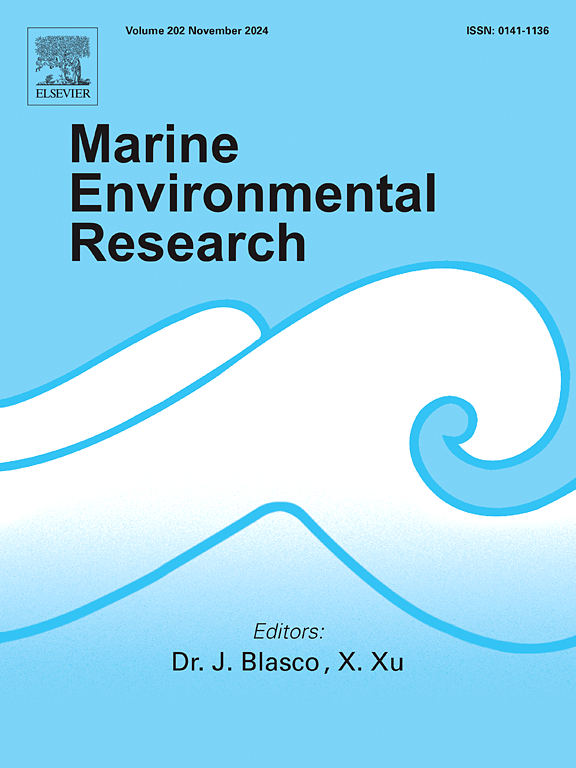Development of universal PCR primers for the environmental DNA metabarcoding of cephalopod (Mollusca) diversity
IF 3
3区 环境科学与生态学
Q2 ENVIRONMENTAL SCIENCES
引用次数: 0
Abstract
Cephalopods play crucial roles in marine ecosystems, acting as both predators and prey for apex predators, thereby contributing to the distribution of energy and nutrients across the food web. Traditional net capture methods are often ineffective for studying cephalopods owing to their wide distribution in marine environments, necessitating the development of simple and efficient surveying techniques to assess cephalopod diversity. Therefore, in this study, we aimed to establish universal polymerase chain reaction primers specifically targeting mitochondrial 16S rRNA genes for environmental DNA metabarcoding in cephalopods. Two primer sets, Cep16S_D and Cep16S_O, were designed for squids and octopuses, respectively. Taxonomic specificity, resolution, and coverage of these primers were evaluated via in silico and in vitro analyses. Additionally, efficiency of these primer sets was assessed using tissue samples and mock communities. Finally, their applicability and performance were tested at various depths. The developed primers exhibited a relatively large amplification size with mixed bases that enhanced their amplification efficiency and sensitivity for cephalopod detection. We successfully identified cephalopod species with different body sizes, from small species, such as Heteroteuthis dagamensis, to large species, such as Architeuthis dux, at varying water depths. Overall, the primer sets established in this study serve as powerful tools to study cephalopod diversity and exhibit great potential for barcoding and genetic diversity investigations.

头足类(软体动物)多样性环境DNA元条形码通用PCR引物的开发
头足类动物在海洋生态系统中扮演着至关重要的角色,既是捕食者,也是顶级捕食者的猎物,从而有助于能量和营养物质在整个食物网中的分布。由于头足类动物在海洋环境中的广泛分布,传统的网捕方法往往对研究头足类动物无效,因此有必要开发简单有效的调查技术来评估头足类动物的多样性。因此,在本研究中,我们旨在建立针对线粒体16S rRNA基因的通用聚合酶链反应引物,用于头足类动物环境DNA元条形码编码。Cep16S_D和Cep16S_O分别为鱿鱼和章鱼设计了引物。这些引物的分类特异性、分辨率和覆盖率通过硅和体外分析进行评估。此外,利用组织样本和模拟群落评估了这些引物组的效率。最后,对其在不同深度下的适用性和性能进行了测试。该引物具有较大的混合碱基扩增量,提高了头足类动物检测的扩增效率和灵敏度。我们在不同的水深成功地鉴定了不同体型的头足类动物,从小物种(如Heteroteuthis dagamensis)到大物种(如Architeuthis dux)。总的来说,本研究建立的引物集是研究头足类动物多样性的有力工具,在条形码和遗传多样性研究中具有很大的潜力。
本文章由计算机程序翻译,如有差异,请以英文原文为准。
求助全文
约1分钟内获得全文
求助全文
来源期刊

Marine environmental research
环境科学-毒理学
CiteScore
5.90
自引率
3.00%
发文量
217
审稿时长
46 days
期刊介绍:
Marine Environmental Research publishes original research papers on chemical, physical, and biological interactions in the oceans and coastal waters. The journal serves as a forum for new information on biology, chemistry, and toxicology and syntheses that advance understanding of marine environmental processes.
Submission of multidisciplinary studies is encouraged. Studies that utilize experimental approaches to clarify the roles of anthropogenic and natural causes of changes in marine ecosystems are especially welcome, as are those studies that represent new developments of a theoretical or conceptual aspect of marine science. All papers published in this journal are reviewed by qualified peers prior to acceptance and publication. Examples of topics considered to be appropriate for the journal include, but are not limited to, the following:
– The extent, persistence, and consequences of change and the recovery from such change in natural marine systems
– The biochemical, physiological, and ecological consequences of contaminants to marine organisms and ecosystems
– The biogeochemistry of naturally occurring and anthropogenic substances
– Models that describe and predict the above processes
– Monitoring studies, to the extent that their results provide new information on functional processes
– Methodological papers describing improved quantitative techniques for the marine sciences.
 求助内容:
求助内容: 应助结果提醒方式:
应助结果提醒方式:


